By Rob Harris
London: Queen Elizabeth II, Britain’s longest reigning monarch and a symbol of continuity and stability from the postwar era into the 21st century, has died. She was 96.
Her death at Balmoral Castle, in the Scottish Highlands, was announced at 6.30pm London time (3.30am AEST) – just three months after Britain held four days of public celebrations for her Platinum Jubilee, which marked her 70 years on the throne.
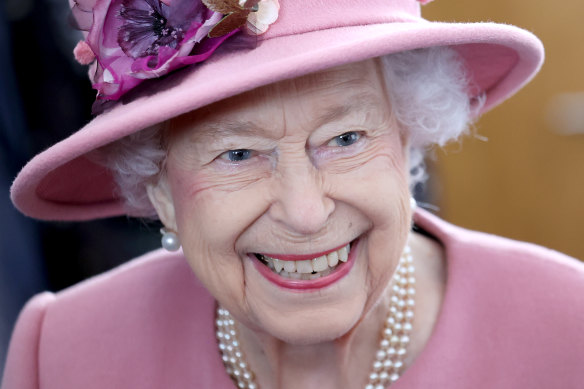
Queen Elizabeth II was the longest-reigning monarch in English history.Credit: Getty Images
On Wednesday, the palace announced her doctors had ordered the Queen to rest just a day after she appointed the 15th British prime minister of her reign, Liz Truss. Less than 24 hours later it was confirmed her doctors were “concerned” for her health and recommended she be put under medical supervision. All of her children and several other family members travelled to Scotland to be by her side.
In a statement, Buckingham Palace said: “The Queen died peacefully at Balmoral this afternoon. The King and The Queen Consort will remain at Balmoral this evening and will return to London tomorrow.”
Charles has succeeded his mother as King and head of the royal family, with a coronation ceremony to be staged at Westminster Abbey in the coming months. The 73-year-old is the oldest newly crowned monarch in British history. He has been first-in-line to the throne since he was three.
In a statement, King Charles III said: “The death of my beloved Mother, Her Majesty The Queen, is a moment of the greatest sadness for me and all members of my family.
“We mourn profoundly the passing of a cherished Sovereign and a much-loved Mother. I know her loss will be deeply felt throughout the country, the Realms and the Commonwealth, and by countless people around the world.
“During this period of mourning and change, my family and I will be comforted and sustained by our knowledge of the respect and deep affection in which The Queen was so widely held.”
Her death will plunge Britain and 14 other realms, including Australia, into an official period of mourning which will be observed throughout more than 30 other Commonwealth member states, almost all former territories of the British Empire.
The King is expected to make a formal address within 24 hours and meet with British Prime Minister Liz Truss.
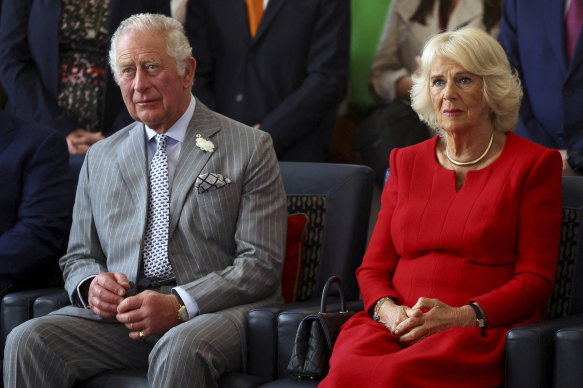
Prince Charles, seen here with his wife Camilla, Duchess of Cornwall, becomes King.Credit: Reuters
Truss, one of the last people to meet with the Queen two days before her death, said the late monarch was “the rock on which modern Britain was built”. She was informed of the Queen’s death at 4.30pm – two hours before the official announcement.
“Our country has grown and flourished under her reign,” she told the nation from Downing Street.
“Britain is the great country it is today because of her … She was the very spirit of Great Britain – and that spirit will endure.”
Australia’s Prime Minister Anthony Albanese said the relationship between Australia and Britain matured and evolved throughout the Queen’s reign.
“The Queen greeted each and every change with understanding, good grace and an abiding faith in the Australian people’s good judgment,” he said.
“This was the deft and diplomatic way she bound the diversity of the modern Commonwealth, nations around the world who will mourn her passing.”
He said her death marked the close of the second Elizabethan age.
“This time of mourning will pass but the deep respect and warm regard in which Australians always held Her Majesty will never fade,” he said.
Among those who have paid tributes are US President Joe Biden, French President Emmanuel Macron and six former British prime ministers, including Sir John Major, Sir Tony Blair and Boris Johnson.
Australia’s Governor-General, David Hurley, said the Queen has offered a lifetime of tireless service.
“When I reflect on my own memories – she was my Queen for my whole life – I think of Her Majesty’s dignity and her compassion,” he said in a statement. “Her dedication and tireless work ethic. And her selflessness and unwavering commitment to the people that she served. To us.”
Elizabeth became sovereign in 1952 following the death of her father, King George VI. She was just 25 at the time and in the 70 years since has morphed into an adored leadership figure and one of the world’s most admired women.
Her death will spark new speculation over the monarchy’s long-term future and fuel debate in Commonwealth countries such as Australia about whether it is time for them to become a republic.
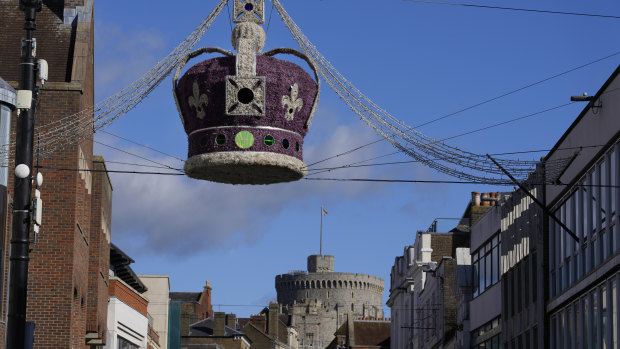
Street lights in the design of a crown hang near Windsor Castle, as the Queen rested after a night in hospital in October.Credit: AP
Prince Philip, the Queen’s husband of 73 years, died at Windsor Castle in April 2021 after being treated in hospital for an infection and heart condition. He was just two months short of his 100th birthday.
The Queen is survived by her four children Charles, Princess Anne, Prince Andrew and Prince Edward, eight grandchildren and 10 great-grandchildren.
She had travelled to her private Scottish home of Balmoral for the start of her traditional summer break on July 21. Her death has triggered Operation Unicorn, the codename for the monarch’s carefully designed funeral plans in the case of her death at Balmoral.
Her coffin is expected to lie in state in Westminster Hall in central London for four days for the public to file past and pay their respects. More than 200,000 people attended when the Queen Mother’s body was laid in state in 2002.
A funeral is expected to be held at Westminster Abbey within nine days, followed by a smaller family service at Windsor Castle within 12 days.
The Queen permanently moved from Buckingham Palace to Windsor Castle west of London at the start of the coronavirus pandemic in 2020.
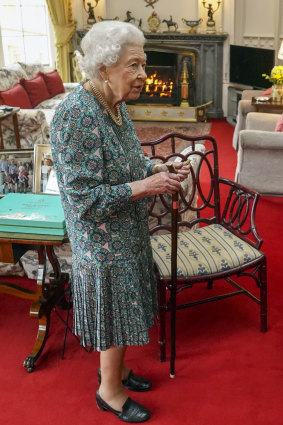
“As you can see, I can’t move”: The Queen now uses a walking stick. Credit: POOL PA
She was just 25 when she became Queen Elizabeth II on February 6, 1952, on the death of her father and reigned for 70 years and 214 days – a record beaten only by France’s Louis XIV (72 years and 110 days).
Public appearances became increasing rare in 2022. She missed events such as the Commonwealth Day Service in March and Easter Sunday service in April as the palace wound back her official duties amid speculation she had been forced into a wheelchair because of her worsening mobility.
When she did undertake public duties she was visibly more frail than she had been previously, often seen using a walking stick.
This week she broke a longstanding tradition and met with Truss at Balmoral and invited her to form government. The Queen had performed the ceremony at Buckingham Palace since she came to the throne.
On February 20, the palace announced that she had tested positive for COVID-19, a week after Prince Charles announced he had contracted the disease for the second time.
The Queen had received three doses of a coronavirus vaccine and had spent most of the first two years of the pandemic isolating at Windsor Castle in a protective bubble of trusted and continuously tested attendants.
Just days before her COVID diagnosis was announced, she told two military visitors to Windsor Castle that, “as you can see, I can’t move”, when she stood to greet them while leaning upon her cane.
In May, she missed the annual state opening of parliament for just the third time, handing over the constitutional duties for the first time to Charles, in a significant moment of his gradual transition to sovereign.
She made only brief appearances at her Jubilee celebrations, both times on the palace balcony with her family to wave to adoring crowds. But she did provide one show-stopping moment in a short skit alongside Michael Bond’s Paddington Bear to open a pop concert in her honour.
She addressed her own mortality in a pre-recorded video address to delegates at the Glasgow Climate Summit in November 2021.
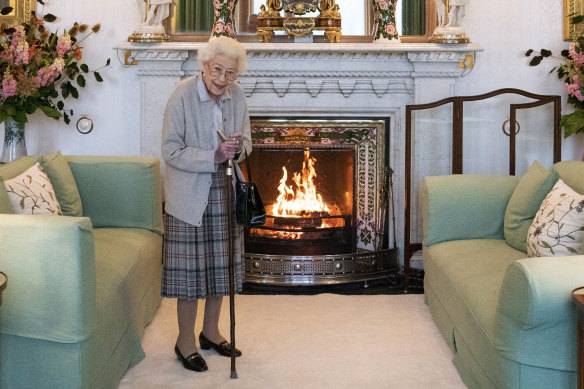
Queen Elizabeth photographed on Tuesday when she met new British Prime Minister Liz Truss.Credit: PA
“It is the hope of many that the legacy of this summit – written in history books yet to be printed – will describe you as the leaders who did not pass up the opportunity; and that you answered the call of those future generations,” she said.
“That you left this conference as a community of nations with a determination, a desire, and a plan to address the impact of climate change; and to recognise that the time for words has now moved to the time for action.
“Of course, the benefits of such actions will not be there to enjoy for all of us here today: none of us will live forever.
“But we are doing this not for ourselves but for our children and our children’s children, and those who will follow in their footsteps.”
She has been served by 15 British prime ministers: Winston Churchill, Anthony Eden, Harold Macmillan, Alec Douglas-Home, Harold Wilson, Edward Heath, James Callaghan, Margaret Thatcher, Major, Blair, Gordon Brown, David Cameron, Theresa May, Johnson and Truss.
In Australia, 16 prime ministers spanned her reign, beginning with Sir Robert Menzies.
Under protocols laid out in Operation London Bridge, Governor-General David Hurley was the first Australian notified about the Queen’s death. Prime Minister Anthony Albanese was then told and delivered the news to members of the cabinet and the opposition leader.
Receive a wrap of our coverage as the world mourns Queen Elizabeth II in our Morning Edition newsletter. Sign up here.